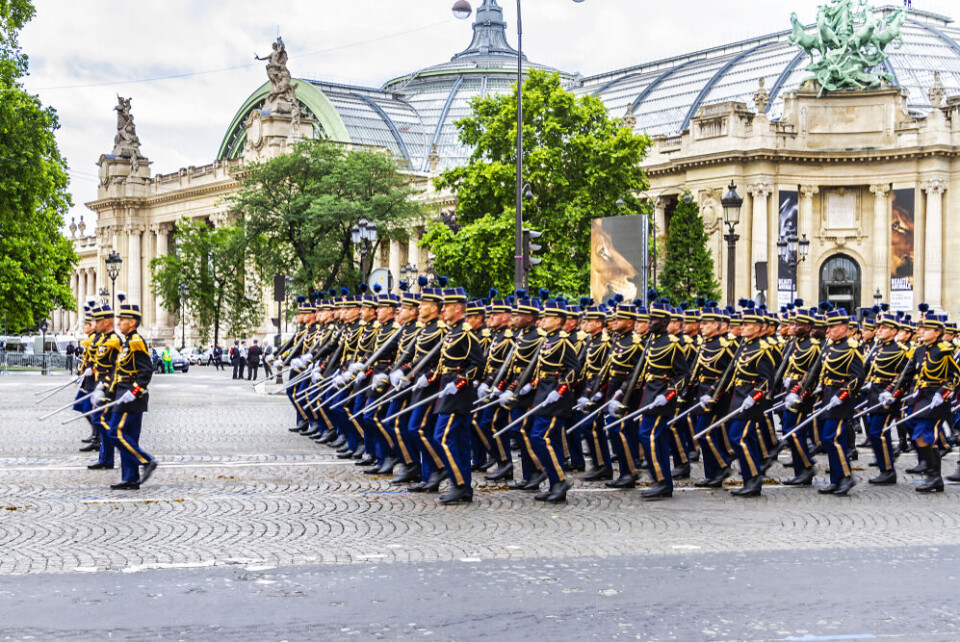La Fête Nationale: 14 facts about France's national holiday
The July 14 'Bastille Day' celebration features a military parade in Paris and means a day off work
7,000 people, 200 horses and 102 aircraft will take part in the traditional Bastille Day military parade 2025
Kiev.Victor / Shutterstock
France's national day (July 14) is a bank holiday, creating a long weekend for many in 2025 as it falls on a Monday.
The official celebrations will be broadcast live on French television channels TF1 and France 2 from 06:00, with the traditional military parade beginning at 10:00. Le Figaro are also showing the parade live on their YouTube channel.
FranceInter and FranceTV will broadcast a concert played by l’Orchestre National de France at 21:00 and viewers can tune back in at 23:00 to admire the fireworks display from the Eiffel Tower.
Prolong the festivities throughout this special day and impress your French friends by bringing up these 14 facts about le quatorze juillet.
1. It is not actually called 'Bastille Day' in France
Although it is known as Bastille Day in English-speaking countries, in France it is formally known as La Fête Nationale, and commonly le quatorze juillet.
Read also: Learning French: test your Bastille Day vocabulary
2. The first celebration was called the Fête de la Fédération
It took place on July 14, 1790. However, the first official Fête Nationale did not happen until July 14, 1880.
3. It commemorates the beginning of the French Revolution in 1789
On this day, more than 200 years ago, revolutionaries stormed the notorious Bastille prison, which had become a symbol of royal oppression in Paris.
4. The Bastille was originally a fortress
It was built around 1370 to defend Paris from the English in the 100 Years War. It later became a prison and housed many political prisoners.
5. La Fête Nationale could have been on August 4
August 4 was also considered as a possible date for the Fête Nationale, as it marked the end of the feudal system in France in 1789.
6. Local prefects are encouraged to party hard
The date of the Fête Nationale was written into law on July 6, 1880, and the Interior Ministry recommended to prefects that the day should be "celebrated with all the brilliance that the local resources allow".
7. The July 14 military parade is the oldest in Europe
The military parade along Paris’s Champs-Elysées on July 14 is the oldest and grandest regular military parade in Europe. It was first held on July 14, 1880.
The 2025 edition will focus on three main themes: a double centenary of remembrance, strategic solidarity with France's partners, and the engagement of young people.
This year's parade will also honour Indonesia, with over 450 Indonesian soldiers opening the défilé.
2025 also marks the 100th anniversary of the Bleuet de France. Cornflowers play a similar as the British tradition of the poppy, and are worn as a symbol of remembrance and solidarity with WW1 veterans.
8. There were just a few prisoners in the Bastille when it was stormed
When it was stormed, the Bastille was found to house only seven prisoners - four forgers, two “lunatics” and one “deviant” aristocrat, the Comte de Solages. The notorious Marquis de Sade had been transferred out of the prison 10 days earlier.
9. Louis XVI only found out about it the next day
The king, Louis XVI, was not informed of the attack on the Bastille until the following day. He reportedly asked if it marked the start of a revolt - only to be told: “No sire, it is a revolution.”
10. The original stone foundations of the Bastille are now in central Paris
Much of the Bastille was destroyed by November 1789. Today, only a few stone foundations remain - and they have been relocated to the side of the Boulevard Henri IV in Paris.
11. The original key to the Bastille is in America
Unlike the prison, the key to the Bastille still exists. It can be found in George Washington's residence of Mount Vernon. It was sent to him by the Marquis de la Fayette in 1790 - who had been a key player in the American War of Independence.
12. Belgium also celebrates Bastille Day
Liege, in Belgium, has also marked Bastille Day since the end of the First World War. The city was awarded the Legion d’honneur in recognition of its resistance against advancing German forces in the Battle of Liege at the start of the conflict.
13. As does Sacramento in California
Sacramento, California, meanwhile, marks the day with a street festival featuring "waiter races" in the midtown restaurant and shopping district.
14. A million people once attended a Bastille Day concert in Paris
In 1979, one million people attended Jean-Michel Jarre’s Bastille Day concert at Place de la Concorde. At the time it was a world-record crowd for a concert.





























